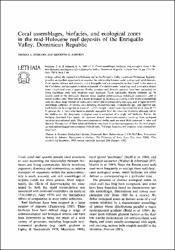/admin/item?itemID=ac307364-3dbc-47c1-a00a-876d6c45188d
Coral assemblages, biofacies, and ecological zones in the mid‐Holocene reef deposits of the Enriquillo Valley, Dominican Republic

View/
Type of Access
OpenMaterial Type
ArticleType of Content
Scientific researchSubject
Recursos naturales - República DominicanaRecursos costeros y marinos
Arrecifes de coral
Paleobiología
Language
EnglishCollection
- Investigación ambiental [1701]
Metadata
Show full item record| Abstract: | A large, subaerially exposed mid‐Holocene reef in the Enriquillo Valley (southwest Dominican Republic) provides an excellent opportunity to examine the relationship between reefal ecology and reefal deposits. Coral species richness and diversity in the Enriquillo reef are comparable to that found in the recent of the Caribbean, and ecological zonation comprised of a shallow‐water branching coral zone and a deeper water mixed‐coral zone is apparent. Similar zonation and diversity patterns have been recognized on living Caribbcan reefs with moderate wave exposure. Three statistically discrete biopdcies can be discriminated in the Enriquillo deposits using quadrat point‐counting techniques commonly used to census modern reefs. They include a facies dominated by Acropora cervicornis, a low diversity assemblage with abundant, large colonies of Siderastrea siderea and Stephanocoenia intersepta, and a higher diversity assembbdge composed of various taxa including Montastraea spp., Colpophyllia spp., and Agaricia spp. Each facies can be recognized at scales of 1–3 m2, though in some cases they extend for more than 20 m2. In general, the A. cervicornis facies is spatially segregated from the other two biofacies. although neither the shallow nor the deep‐water ecological zone is comprised of a single reef biofacies. Rather, the biofacies described here appear to represent distinct micro‐environments resulting from ecological variation at a subzonal scale. Micro‐environments of similar scale are most likely preserved in other reef deposits. Recognition of these subzonal biofacies may have important consequences for the stratigraphical and paleoccological interpretation of fossil reefs. |
| Author(s): | Stemann, Thomas A.
Johnson, Kenneth G. |
| Date: | 1992 |
| Published: | Lethaia, 25(3), 231-241 |
| Citation: | Stemann, T. A., & Johnson, K. G. (1992). Coral assemblages, biofacies, and ecological zones in the mid‐Holocene reef deDosits of the Enriquillo Valley, Dominican Republic. Lethaia, 25(3), 231-241. Recuperado de: |
| URI: | https://bvearmb.do/handle/123456789/5780
|

